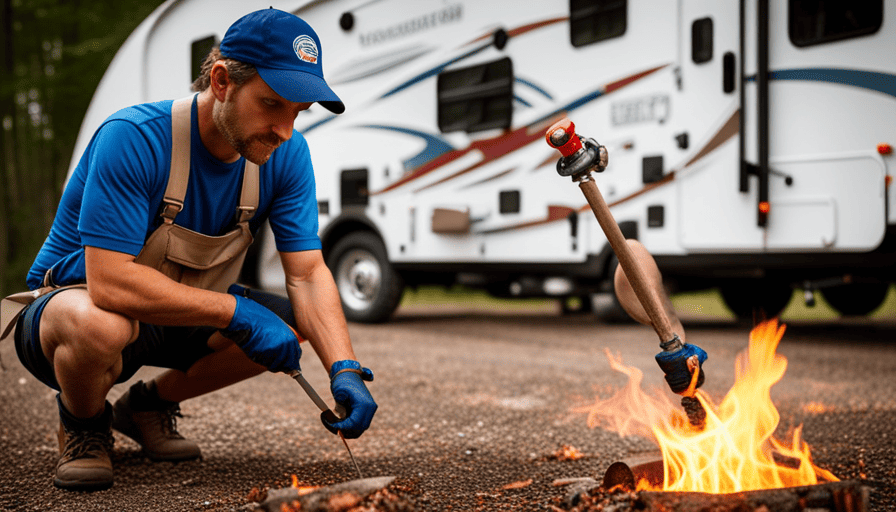Ever curious about the weight of a teardrop camper? Imagine a small, compact trailer, shaped like a teardrop, crafted to offer a snug and pleasant camping adventure. These delightful compact trailers have become increasingly popular, providing an easy and minimalist approach to journeying and discovering the vastness of nature. But, what exactly does one of these weigh?
In this article, I will delve into the weight considerations of teardrop campers. We will explore the structure of these trailers, understand the importance of weight limits, and discuss the factors that contribute to their overall weight.
Additionally, I will guide you on how to determine the weight of your teardrop camper and the impact it has on towing and maneuverability. We will also touch upon weight distribution and safety considerations when towing a heavier camper.
So, if you’re curious about the weight of teardrop campers and want to find the right balance between comfort and weight, keep reading!
Key Takeaways
- Teardrop campers are compact trailers built on lightweight chassis with materials like aluminum, fiberglass, or wood.
- Proper weight distribution is crucial for stability and balance when towing a teardrop camper.
- Exceeding weight limits strains the tow vehicle, reduces fuel efficiency, and affects braking ability.
- Factors such as construction materials, size, dimensions, interior amenities, and water/fuel capacity contribute to the weight of a teardrop camper.
Understanding the Structure of a Teardrop Camper
If you’re curious about the structure of a teardrop camper, you’ll be amazed at how its compact design maximizes space while still providing all the necessary amenities for a comfortable camping experience. Understanding teardrop design is key to appreciating its unique features.
These campers are typically built on a lightweight chassis, which contributes to their overall weight efficiency. The body is constructed using a combination of materials such as aluminum, fiberglass, or wood, ensuring durability without adding unnecessary bulk. The streamlined shape of the teardrop camper allows for improved aerodynamics, reducing drag and increasing fuel efficiency when towing.
Inside, you’ll find a cozy sleeping area, often accommodating two people, as well as a small kitchenette with basic appliances like a stove and a sink. The benefits of lightweight construction are evident in the ease of towing and maneuverability. Teardrop campers can be effortlessly towed by a variety of vehicles, making them a popular choice among campers.
Understanding the structure of a teardrop camper allows us to appreciate the clever design that balances functionality and comfort. Now let’s delve into the importance of trailer weight limits.
The Importance of Trailer Weight Limits
Trailer weight limits play a crucial role in ensuring safe and efficient towing experiences. These limits are set by manufacturers to ensure that the trailer is not overloaded, which can lead to instability, reduced control, and increased risk of accidents. When it comes to teardrop campers, it’s important to understand and adhere to these weight limits to avoid any potential issues on the road.
One of the key aspects of trailer weight limits is weight distribution. It’s not just about the overall weight of the camper, but also how that weight is distributed. Proper weight distribution ensures that the trailer is balanced and stable, making it easier to tow. This involves placing heavier items towards the front of the trailer and distributing the weight evenly side to side.
Exceeding the trailer weight limits can lead to a variety of problems. It can put excessive strain on the tow vehicle, causing damage to the engine, transmission, and suspension. It can also lead to poor fuel efficiency and difficulty in braking and maneuvering.
Understanding and respecting the trailer weight limits is essential for a safe and enjoyable towing experience. By adhering to these limits and properly distributing the weight, you can prevent potential issues and ensure a smooth journey.
Moving forward, let’s explore the factors that contribute to the weight of a teardrop camper.
Factors That Contribute to the Weight of a Teardrop Camper
When considering the weight of a teardrop camper, several factors come into play. First and foremost is the construction materials used. The type and quantity of materials used can greatly affect the overall weight of the camper.
Additionally, the size and dimensions of the camper play a role in its weight, as larger campers typically weigh more than smaller ones.
Finally, the interior amenities and features, such as kitchen appliances and bathroom fixtures, can add significant weight to the camper. Lastly, the water and fuel capacity of the camper also contribute to its overall weight.
Construction Materials
Teardrop campers are typically built using lightweight yet durable materials. The choice of construction materials is crucial as it directly affects the weight, durability, and maintenance of the camper. The most common materials used for teardrop camper construction are aluminum, fiberglass, and wood. Each material has its own benefits and considerations. Aluminum is lightweight, corrosion-resistant, and easy to maintain, making it a popular choice. Fiberglass is also lightweight, but it offers better insulation and is more resistant to impacts. Wood, on the other hand, provides a classic aesthetic and can be easily repaired, but it requires more maintenance to prevent rotting and warping.
To illustrate the differences, here is a comparison table:
| Material | Weight | Durability | Maintenance |
|---|---|---|---|
| Aluminum | Light | High | Low |
| Fiberglass | Light | High | Medium |
| Wood | Moderate | Medium | High |
Considering the construction materials, the weight of a teardrop camper can vary significantly. Moving on to the next section about size and dimensions, we can further explore the factors that contribute to the overall weight of a teardrop camper.
Size and Dimensions
If you think bigger is always better, prepare to be surprised by the compact size and dimensions of these pint-sized wonders. Teardrop campers are designed to be small and lightweight, making them easy to tow and maneuver.
The average teardrop camper measures around 8 to 10 feet in length and 4 to 6 feet in width. This compact size allows for better fuel efficiency and makes it easier to navigate tight camping spots or narrow roads. When it comes to weight distribution, teardrop campers are designed to have a low center of gravity, ensuring stability on the road.
Towing capacity considerations are important, as larger teardrop campers may require a vehicle with a higher towing capacity. Moving on to the next section about interior amenities and features, you’ll find that these compact campers still offer a surprising amount of comfort and convenience.
Interior Amenities and Features
Step inside these compact wonders and you’ll be amazed at the cozy and luxurious interior amenities they offer. Despite their small size, teardrop campers are designed to maximize space and provide a comfortable living experience.
The interior design of these campers is carefully thought out, with every inch being utilized efficiently. There are clever storage solutions incorporated throughout, such as overhead cabinets, under-bed storage, and built-in drawers. These ensure that you have enough space to store all your camping essentials.
Additionally, teardrop campers often feature a well-equipped kitchenette, complete with a sink, stove, and fridge, allowing you to prepare meals on the go. Some models even have a small dining area and a comfortable sleeping space.
As we move on to the next section about water and fuel capacity, it’s important to note that these campers are designed to provide all the necessary amenities for a comfortable camping experience.
Water and Fuel Capacity
The compact wonders are equipped to hold an ample amount of water and fuel to ensure a smooth and enjoyable camping experience. Teardrop campers typically have built-in water storage tanks that can hold anywhere from 5 to 20 gallons of water. This allows campers to have access to fresh water for cooking, cleaning, and even showering while on the road.
Additionally, teardrop campers are designed to be fuel efficient, making them ideal for long trips. Most teardrop campers have a fuel capacity of around 10 to 20 gallons, depending on the model. This ensures that campers can travel long distances without worrying about running out of fuel.
Moving on to the next section about how to determine the weight of your teardrop camper, it is important to consider factors such as the materials used, additional amenities, and personal belongings.
How to Determine the Weight of Your Teardrop Camper
To accurately gauge the weight of your teardrop camper, you’ll need to rely on a few key indicators.
The first step in determining the accurate weight is to calculate the payload capacity of your camper. This refers to the maximum weight that your camper can safely carry, including all the occupants, gear, water, and fuel.
To calculate the payload capacity, you’ll need to know the weight of the empty camper, as well as the weight of all the additional items that you plan to carry. This includes camping equipment, food, clothing, and any other personal belongings. It’s important to be as accurate as possible when determining these weights, as exceeding the payload capacity can lead to safety issues while towing.
Once you have determined the payload capacity, you can subtract the weight of all the additional items from the maximum capacity to get the weight of the empty camper. This will give you a good estimate of the weight you’ll be towing.
Understanding the weight of your teardrop camper is crucial for safe towing and maneuverability. Exceeding the recommended weight limits can affect your vehicle’s performance, braking distance, and stability on the road. It’s essential to consider the impact of weight on towing and maneuverability to ensure a smooth and safe travel experience.
The Impact of Weight on Towing and Maneuverability
Determining the weight of your teardrop camper is essential for a safe and enjoyable towing experience. In the previous subtopic, I discussed various methods to calculate the weight of your camper. Now, let’s explore the impact of weight on towing and maneuverability.
The weight of your teardrop camper can significantly affect your vehicle’s towing capacity and fuel efficiency. Here are a few key points to consider:
-
Towing Capacity: Every vehicle has a maximum towing capacity, which specifies the weight it can safely tow. Exceeding this limit can strain your vehicle’s engine, suspension, and brakes, compromising safety and performance.
-
Maneuverability: A heavier teardrop camper can make your vehicle less maneuverable. It may require more space for turning, backing up, or changing lanes. This can be particularly challenging in tight parking lots or narrow roads.
-
Fuel Efficiency: Towing a heavier camper increases the drag on your vehicle, causing it to use more fuel. Additionally, the added weight puts a strain on the engine, potentially reducing fuel efficiency further.
-
Stability: A well-balanced teardrop camper, within the recommended weight limits, provides better stability on the road. An imbalanced or overloaded camper can lead to swaying or fishtailing, making towing unsafe.
Understanding the impact of weight on towing and maneuverability is crucial for a smooth and safe journey. Now, let’s move on to the next section, where I’ll provide you with tips for reducing the weight of your teardrop camper.
Tips for Reducing the Weight of Your Teardrop Camper
Ready to hit the road with your teardrop camper? Here are some tips to help you lighten the load and make your journey even more enjoyable!
One of the most effective ways to reduce weight is by using lightweight materials. Look for aluminum or fiberglass for the camper shell, as they’re lighter than traditional wood. Consider replacing heavy appliances with more compact and lightweight alternatives. For example, opt for a portable stove instead of a full-size range.
Additionally, choose lightweight camping gear and pack only the essentials. Remember, every pound counts when it comes to towing and maneuverability.
Another way to reduce weight is by being mindful of what you bring on your trip. Take inventory of your supplies and eliminate any unnecessary items. Swap out heavy items for lighter alternatives, such as using plastic dishes instead of ceramic ones. Also, consider investing in space-saving storage solutions to maximize the available space without adding unnecessary weight.
Understanding weight distribution and proper loading techniques is crucial for a safe and comfortable journey. In the next section, we’ll delve into the importance of evenly distributing weight and how to load your teardrop camper properly.
Understanding Weight Distribution and Proper Loading Techniques
Understanding weight distribution and implementing proper loading techniques are essential for a safe and comfortable journey with your compact camping trailer.
When it comes to weight distribution, there are a few key things to keep in mind:
-
Balance: Make sure to distribute the weight evenly between the front and back of the camper. This will help maintain stability and prevent swaying while on the road.
-
Low and centered: Place heavier items closer to the floor and towards the center of the camper. This will help lower the center of gravity and improve overall handling.
-
Secure everything: Use straps, bungee cords, or other securing methods to keep your belongings in place. This will prevent shifting and potential damage during transit.
By following these loading techniques, you can ensure a smooth ride and reduce the risk of accidents or damage. It’s important to remember that the weight distribution should be adjusted based on the specific make and model of your teardrop camper.
Now that we’ve covered weight distribution and loading techniques, let’s move on to discussing the safety considerations when towing a heavy teardrop camper.
Safety Considerations When Towing a Heavy Teardrop Camper
Ensuring the safe towing of a larger compact camping trailer requires careful attention to safety considerations. When towing a heavy teardrop camper, it is important to understand the limitations of your trailer hitch and the towing capacity of your vehicle. Ignoring these factors can lead to dangerous situations on the road.
To help you understand the importance of safety when towing a heavy teardrop camper, I have prepared a table that outlines the key safety considerations:
| Safety Considerations | Description |
|---|---|
| Trailer Hitch | Ensure your trailer hitch is compatible with your teardrop camper. Check the weight rating and make sure it can handle the load. |
| Towing Capacity | Know the towing capacity of your vehicle and ensure it can safely tow the weight of your teardrop camper. Exceeding the towing capacity can strain your vehicle and compromise safety. |
| Weight Distribution | Properly distribute the weight of your teardrop camper to prevent trailer sway and maintain stability while towing. Make sure the weight is evenly distributed front to back and side to side. |
| Braking System | Consider upgrading your vehicle’s braking system to ensure it can handle the additional weight of your teardrop camper. This will improve your ability to stop safely. |
| Tire Pressure and Maintenance | Regularly check the tire pressure of both your vehicle and teardrop camper. Make sure they are properly inflated and in good condition to avoid blowouts and other tire-related issues. |
By following these safety considerations, you can tow your heavy teardrop camper with peace of mind. However, if you find that your current vehicle is not equipped to handle the load, it may be time to consider upgrading your tow vehicle for heavier loads.
[Transition sentence: In the next section, we will explore the steps to upgrading your tow vehicle to ensure you can safely tow a heavier teardrop camper.]Upgrading Your Tow Vehicle for Heavier Loads
If you’re looking to take your towing game to the next level, it’s time to revamp your trusty steed for a weightier journey. Upgrading your tow vehicle is essential when it comes to hauling heavier loads, such as a teardrop camper.
To ensure a safe and smooth towing experience, here are some key considerations:
-
Upgrading the tow hitch: A stronger tow hitch is necessary to handle the increased weight of a heavier teardrop camper. Look for a tow hitch with a higher weight capacity to ensure it can handle the load.
-
Calculating towing capacity: Before upgrading your tow vehicle, it’s important to determine its towing capacity. This can be found in the vehicle’s owner’s manual or by consulting the manufacturer. Ensure that the towing capacity exceeds the weight of your teardrop camper to prevent any strain or damage.
-
Suspension enhancements: Upgrading your tow vehicle’s suspension can improve stability and control while towing a heavier load. Consider adding airbags or heavy-duty shocks to provide extra support and reduce sagging.
-
Braking system: A heavier teardrop camper requires a more robust braking system. Upgrade to a trailer brake controller that can effectively control and stop the trailer when needed.
Finding the right balance between comfort and weight is crucial when upgrading your tow vehicle for a heavier teardrop camper. By considering these factors and making the necessary enhancements, you can ensure a safe and enjoyable towing experience.
Conclusion: Finding the Right Balance between Comfort and Weight
To make sure my towing experience is both comfortable and safe, it’s important to find the perfect balance between weight and comfort when upgrading my tow vehicle.
When it comes to teardrop campers, finding the right balance is crucial. The weight of a teardrop camper can vary depending on its size and features. It’s important to consider the weight limits of both the tow vehicle and the camper itself.
Exceeding the weight limits can cause significant problems, such as decreased fuel efficiency, reduced braking ability, and increased wear and tear on the tow vehicle. It can also put additional strain on the suspension and tires, potentially compromising the overall safety of the towing experience.
On the other hand, sacrificing comfort for a lighter camper may result in a less enjoyable camping experience. It’s important to consider the amenities and features that are necessary for a comfortable trip, such as sleeping arrangements, kitchen facilities, and storage space.
Finding the right balance between weight and comfort requires careful consideration of the tow vehicle’s capabilities and the camper’s weight. It’s crucial to research and understand the weight limits of both to ensure a safe and enjoyable towing experience.
Frequently Asked Questions
Can a teardrop camper be towed by any vehicle?
Yes, a teardrop camper can be towed by various vehicles, but it’s important to consider the teardrop camper’s towing capacity and choose a vehicle that can handle it. The towing capacity of a teardrop camper can vary depending on its weight and design.
Generally, compact SUVs, minivans, and trucks are suitable for towing teardrop campers. However, it’s always recommended to consult the manufacturer’s guidelines and ensure that your vehicle is equipped with the necessary towing features for a safe and smooth towing experience.
What is the average weight of a teardrop camper?
The average weight of a teardrop camper is around 1,000 to 2,000 pounds. It’s important to consider the towing capacity of your vehicle before purchasing a teardrop camper. This weight range allows for easy towing by most mid-size SUVs and trucks.
It’s advisable to check your vehicle’s towing capacity in the owner’s manual or consult with a professional to ensure that it can safely tow the weight of a teardrop camper.
Are there any weight restrictions for towing a teardrop camper?
Weight restrictions for towing a teardrop camper are an important consideration. It’s crucial to know your vehicle’s towing capacity before hitting the road. Towing capacity refers to the maximum weight a vehicle can safely tow. Exceeding this limit can lead to accidents and damage to your vehicle.
To determine if your vehicle can tow a teardrop camper, consult your vehicle’s owner’s manual or contact the manufacturer. It’s better to be safe and within the weight restrictions to ensure a smooth and safe towing experience.
How does the weight of a teardrop camper affect fuel efficiency?
Investigating the impact of a teardrop camper’s weight on fuel efficiency reveals a complex relationship.
While it’s true that a lighter camper generally improves fuel efficiency, the design of the teardrop camper plays a significant role as well.
Aerodynamic designs, such as curved roofs and streamlined shapes, reduce drag and enhance fuel efficiency.
Additionally, factors like tire pressure, vehicle engine size, and driving conditions also contribute to the overall towing experience.
Are there any safety considerations when towing a lightweight teardrop camper?
When towing a lightweight teardrop camper, there are important safety considerations to keep in mind. Firstly, it’s crucial to check tire pressure regularly to ensure optimal performance and prevent blowouts.
Additionally, maintaining a safe towing speed is essential for stability and control. Following the manufacturer’s guidelines and recommendations for tire pressure and towing speed will help ensure a safe and enjoyable towing experience.
How Does the Weight of a Teardrop Camper Affect Its Measurement?
The weight of a teardrop camper plays a crucial role in determining its overall measurement. Understanding how camper measurements work is vital for proper planning and transportation. By taking into account factors such as the camper’s weight, length, and width, one can ensure a smooth and safe journey. So, before hitting the road, make sure to consider how camper measurements work to avoid any complications.
Conclusion
In conclusion, finding the right balance between comfort and weight is crucial when it comes to towing a teardrop camper. Understanding the structure and weight limits of the camper is essential for safe towing and maneuverability.
One interesting statistic to note is that the average weight of a teardrop camper ranges from 1,000 to 2,500 pounds, depending on its size and features. It’s important to consider weight distribution and proper loading techniques to ensure stability on the road. Additionally, upgrading your tow vehicle may be necessary to handle heavier loads. When choosing a teardrop camper, it’s helpful to consult a camper weight guide to determine the best fit for your specific towing capacity. These guides provide valuable information on different camper weights and how they relate to various tow vehicles. By using a camper weight guide, you can make an informed decision and ensure a safe and smooth towing experience.
Overall, prioritizing safety and understanding the impact of weight will lead to a more enjoyable camping experience.











